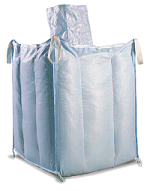 There are a number of factors involved in successfully stacking bulk bags. The one most overlooked is that your filled bulk bags must have a flat top!
There are a number of factors involved in successfully stacking bulk bags. The one most overlooked is that your filled bulk bags must have a flat top!
Most dry bulk solids have an angle of repose. If you pored a handfull of your product on a flat surface it would form a peak. The angle of the peak with the horizontal varies depending on the properties of the product.
When product is poured into a bulk bag it forms a peak just the same as the example above. However, if you plan to stack bulk bags it is critical that your bulk bag filling equipment densifies the product enough to produce a flat top.
A filled bulk bag with a flat top provides a stable platform on which to stack. Without it, the odds of a leaning or falling stack are greatly increased.
If you are stacking bulk bags or plan to, safety is the first priority. Make certain that your bulk bag filling equipment can produce a flat topped bag before you do anything else!
See how Control and Metering's cone table densifiction technology produces flat topped bulk bags!

 Baffles are pieces of plastic fabric that are sewn vertically across each of the four corners of a bulk bag. The fabric pieces have holes in them so that product can flow 'through' them and fill the corners of the bag.
Baffles are pieces of plastic fabric that are sewn vertically across each of the four corners of a bulk bag. The fabric pieces have holes in them so that product can flow 'through' them and fill the corners of the bag.
